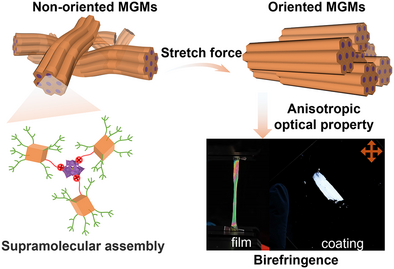Stretch-Induced Structural Ordering and Orientation for Tensile Yield Behavior and Anisotropic Optical Property of Molecular Granular Materials
Graphical Abstract
The molecular granular materials (MGMs) based on functional molecular clusters with hierarchical structures can be feasibly synthesized through supramolecular interaction. The stretch process contributes to the structural orientation and ordering of the MGMs with viscoelasticity and anisotropic optical property.
Abstract
The densely packed sub-nm particles, molecular granular materials (MGMs), represent a new class of functional materials that deliver distinct mechanical properties from polymers and conventional granular materials. However, their costly synthesis and the vague understanding of their mechanical property hinder extensive progress. Herein, the supramolecular complexation approach is developed for the feasible construction of MGMs with hierarchical structures, while in situ small angle X-ray scattering (SAXS) is applied to monitor the mechanical deformation of MGMs for microscopic understanding. Amphiphilic oligomers are assembled from the ionic attraction of 1 nm molecular clusters and further pack into ordered hexagonal phases (HEX1) driven by hydrophobic interaction. Interestingly, stretching can induce structural orientation, and thus triggering the transformation of HEX1 to another hexagonal phase (HEX2) with denser packing, accounting for the tensile yield behavior of the MGMs. The supramolecular structure endows hierarchical structure relaxation dynamics, enabling their unique viscoelasticity with a resilient rubbery plateau even at high temperatures. Their flexibility renders the capability to facilely process the MGMs into highly oriented films and coatings with anisotropic properties for potential applications in optical device fabrications.
Conflict of Interests
The authors declare no conflict of interest.
Open Research
Data Availability Statement
The data that support the findings of this study are available from the corresponding author upon reasonable request.





